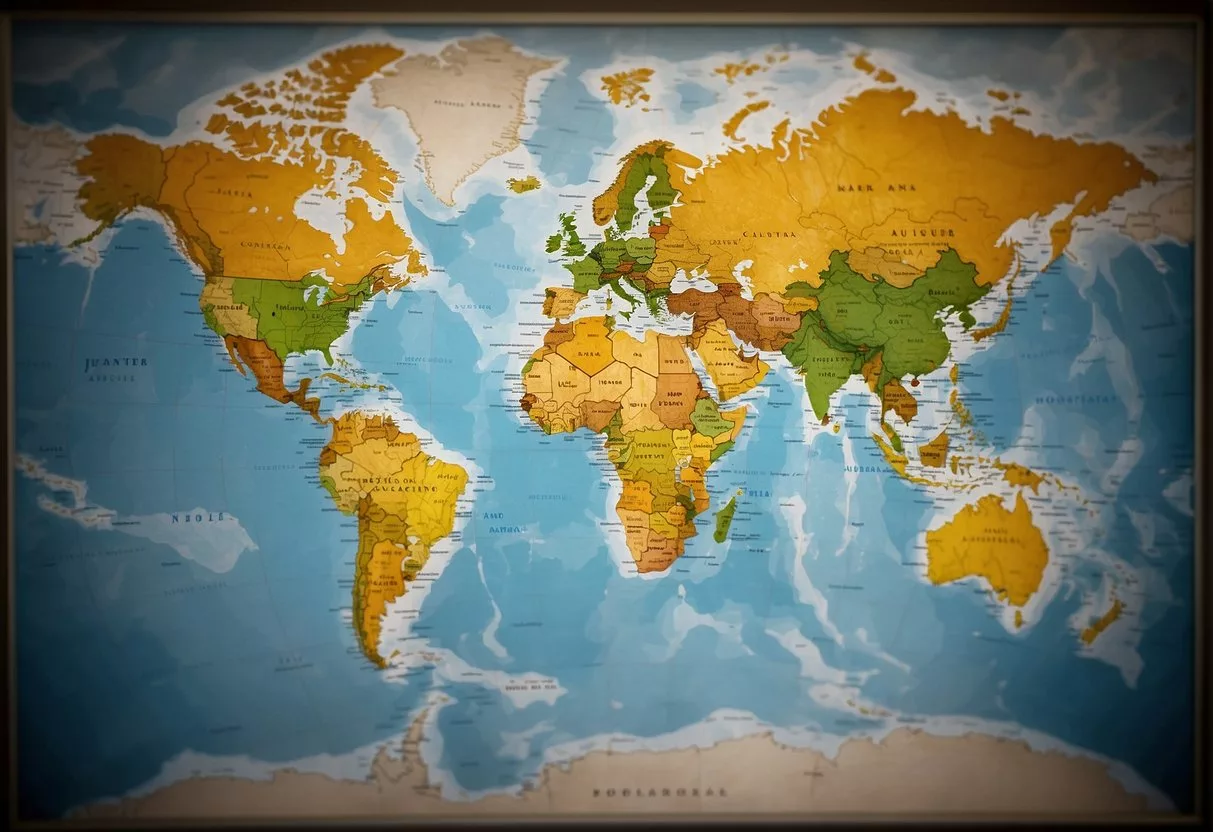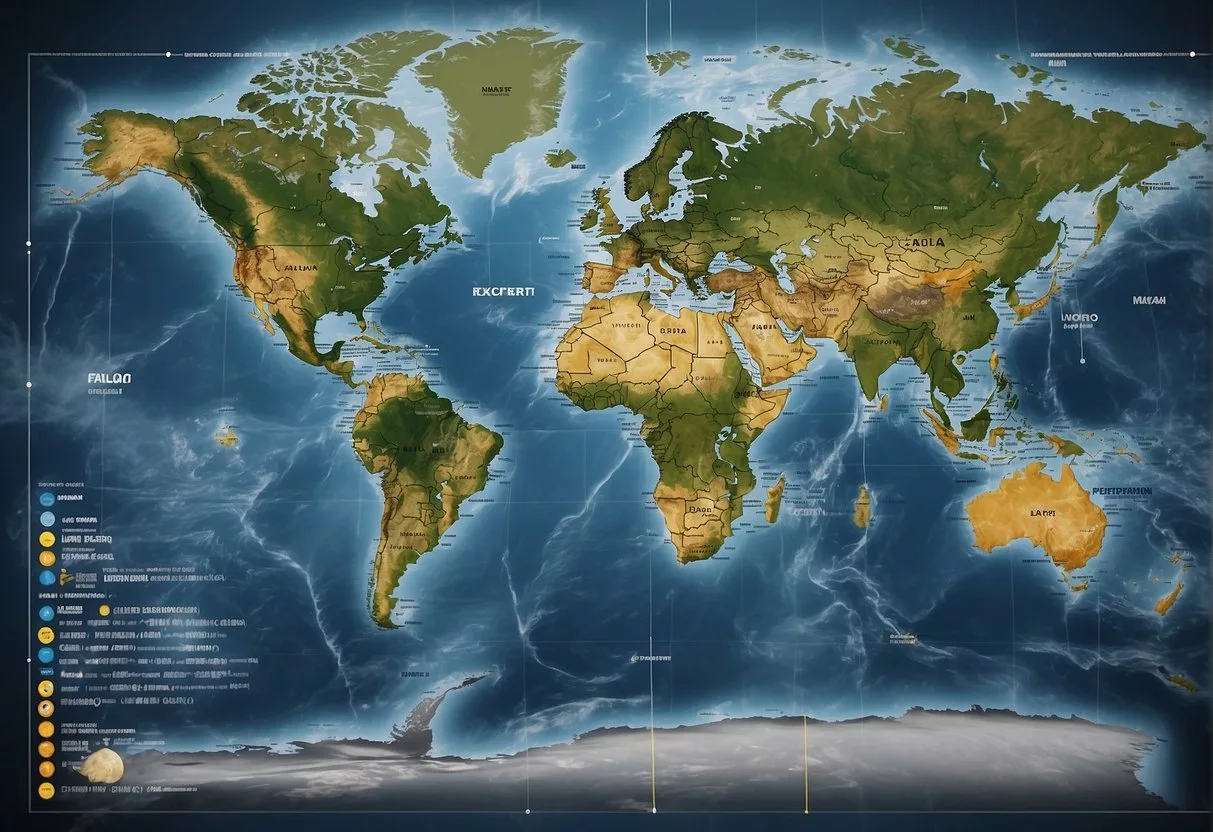The interplay between a person’s geographical location and their well-being is a complex one. In recent years, the concept of geo-medicine has emerged to explore this intricate relationship. Essentially, it posits that the place where a person lives, works, and plays profoundly influences their health.
Much more than a backdrop, geography is often a predictor—sometimes even a determinant—of health outcomes. A growing body of research is now providing compelling evidence that location can be as impactful on an individual’s health as genetic predispositions or lifestyle choices.

This fusion of geographic information with personal health data equips the medical community with a more comprehensive understanding of patient health.
Environmental factors, such as proximity to toxic waste sites or the availability of green spaces, alongside socio-demographic variables like income levels and access to health services, are all pieces of the geo-health puzzle influencing the well-being of populations.
With this new approach, medical professionals can tailor health care more accurately to individual needs.
Key Takeaways
- Geo-medicine links geographic location with health outcomes.
- Comprehensive health care now includes environmental and socio-demographic factors.
- Geo-data integration into health policy is shaping a future of personalized medicine.
Geography is Destiny
The phrase “Geography is destiny” is often used to emphasize how geographical location can significantly influence various aspects of life, including health outcomes. This concept, though not attributed to a single individual as its originator, has roots in the broader field of geographical determinism, which suggests that human habits, behaviors, cultural traits, and even societal developments are shaped or dictated by geographical conditions.
Historical Context
Geographical determinism has been a theme in historical and sociological studies for centuries. Notable figures who have explored related ideas include:
- Hippocrates (circa 460 BC to circa 370 BC), the Greek physician, wrote an essay titled “Airs, Waters, Places” which posited that different environments could influence people’s health and behaviors.
- Ibn Khaldun, a 14th-century Arab scholar, suggested that climate and geography influenced the physical and psychological makeup of different peoples.
- Ellsworth Huntington and Ellen Churchill Semple are early 20th-century geographers who associated environmental conditions with human physiologies and behaviors, although their approaches are now viewed as overly deterministic.
Modern Interpretation
The phrase “Geography is destiny” has been adapted in modern times to discuss disparities in health outcomes:
- Access to Healthcare: Rural vs. Urban – Residents in rural areas often have less access to healthcare services compared to urban areas. This can be due to fewer medical facilities, longer travel times to healthcare providers, and a shortage of healthcare professionals in rural settings.
- Environmental Factors: Pollution and living conditions can vary greatly between different geographical areas. For instance, high levels of air pollution in industrial areas can lead to higher incidences of respiratory diseases compared to more pristine suburban or rural areas.
- Economic Opportunities: Wealthier regions or countries typically have better health outcomes due to greater access to healthcare services, higher quality of life, and more resources dedicated to public health.
- Cultural Practices: Dietary habits influenced by geography can also impact health. Mediterranean diets, for instance, are associated with lower levels of heart disease and have been linked to the geographical availability of certain oils, fish, and fresh produce.
The concept, while useful in highlighting certain trends and patterns, is not without its critics who argue it can oversimplify complex social phenomena or lead to deterministic conclusions that overlook human agency and technological advancements. Despite these criticisms, it remains a useful tool for analyzing how location can impact health outcomes and other aspects of life.
The Concept of Geo-Medicine

Geo-medicine bridges the gap between location and well-being, positing that one’s geographic environment significantly impacts health.
Defining Geo-Medicine
Geo-medicine is the study of the relationship between environmental factors and health outcomes. The field recognizes that geography can influence everything from disease distribution to individual health risks and responses to treatment. By integrating geographic data into medicine, healthcare professionals can obtain a more holistic view of patient health.
The History of Geography in Health
Historically, geography has played a fundamental role in understanding health patterns and disease spread. For instance, the mapping of cholera outbreaks in 19th-century London was instrumental in identifying contaminated water sources. This illustrates the enduring connection between location and health long before the formalization of geo-medicine.
Bill Davenhall’s Contribution
Bill Davenhall, a prominent figure at Esri, brought significant attention to geo-medicine with his TEDMED talk, advocating the inclusion of geographic information in medical records. He argued that doctors should incorporate place history into health assessments, much like family and medical histories.
Advancements in Geographic Information Systems
Advancements in Geographic Information Systems (GIS) have transformed geo-medicine. These systems allow for precise mapping and analysis of environmental factors related to health. Organizations such as Esri are pioneering the use of GIS in healthcare, providing tools that combine patient data with geospatial information to enhance clinical decision-making and public health surveillance.
Geo-Data in Personal Health

The intertwining of geographic data with personal health information marks a significant shift in medical practice. It emphasizes the potential of geo-data to enhance the understanding of health risks associated with different locations.
Medical Records and Geographic Data
Integrating geographic data into medical records can provide valuable context about environmental exposures and potential health risks unique to specific areas. For instance, a physician might note an increased prevalence of respiratory issues in a region known for high pollen counts or industrial pollution.
The history of a patient’s location often yields insights, informing both prevention and treatment strategies in healthcare practice.
The Role of Physicians and Geo-Data
Physicians are finding geo-data increasingly indispensable for offering personalized care. By understanding the linkage between a patient’s health and their history of geographic locations, doctors can tailor their diagnostics and recommendations. The practice, often referred to as “geo-medicine,” is becoming a part of forward-thinking healthcare approaches, enabling physicians to think spatially in relation to patient health.
Mobile GPS Apps and Health
The advent of mobile GPS apps integrates real-time geographic data to make health information even more dynamic and personalized. These technology applications serve as tools for not only navigation but also tracking potential environmental health hazards.
For example, they can alert individuals to nearby toxic dumpsites or areas with poor air quality, leading to informed lifestyle choices related to their health.
Environmental Factors Affecting Health

The spaces we inhabit, from the air we breathe to the services available, shape our health outcomes. Diverse environmental factors converge, influencing public health in profound ways.
Analyzing Environmental Data
Understanding health trends requires robust environmental data. By examining patterns in data, such as local heart-attack rates or proximity to toxic waste sites, researchers can establish correlations between health and environment.
This analysis by Dr. Mark Green elucidates the complex relationship between our surroundings and our wellbeing.
Impact of Pollution on Public Health
Every day, pollutants like exhaust and industrial emissions compromise air quality, contributing significantly to respiratory conditions such as asthma. Cities with higher levels of air pollution experience escalated rates of health issues, underscoring the urgency in minimizing emissions to protect public health.
Climate Change and Disease Prevalence
Climate change is more than a global temperature concern—it’s a health hazard. It alters disease patterns, expanding the range and prevalence of vector-borne illnesses. Increased temperatures and changing weather patterns can exacerbate chronic conditions, including cardiovascular disease and diabetes.
The Urban vs. Rural Health Divide
Differences between urban and rural areas are stark, affecting healthcare services accessibility.
Cities may offer better healthcare infrastructure, but often contend with higher pollution levels. Conversely, rural areas may have cleaner environments but lack immediate proximity to comprehensive healthcare facilities. This divide reveals how geography can be a determinant of health destiny.
Socio-Demographic Variables and Health Outcomes

The factors of age, genetics, socioeconomic status, and even zip code play defined roles in shaping an individual’s health outcomes. These variables can predict longevity, disease prevalence, and accessibility to healthcare resources with surprising precision.
Influence of Age and Genetics
One’s health is significantly influenced by age and genetic predispositions.
As individuals age, they are more susceptible to chronic diseases, a phenomenon supported by longitudinal studies. For instance, osteoarthritis is more prevalent among the elderly, reflecting the cumulative effect of wear and tear on joint tissues, which is compounded by hereditary factors that may predispose an individual to such conditions.
- Children and Adolescents: Typically exhibit fewer age-related diseases but may manifest genetic disorders early in life.
- Adults: May experience adult-onset genetic conditions and are also subject to lifestyle-related health issues.
- Seniors: Increased incidence of degenerative diseases, often reflecting the combination of age-related changes and genetic factors.
Impact of Socioeconomic Status
Socioeconomic status (SES) is a powerful determinant of health outcomes.
Studies show that higher SES correlates with better access to healthcare services, healthier food options, and reduced stress levels. Conversely, lower SES is associated with an increased risk of various diseases, from hypertension to diabetes.
- Employment and Income: Directly affect the ability to afford healthcare and maintain a healthy lifestyle.
- Education: Often dictates health literacy and the capacity to navigate health systems effectively.
Zip Code as a Health Determinant
Geographic location, often encapsulated in one’s zip code, can forecast health outcomes with startling accuracy.
Geo-demographic models employed by geographers and public health officials illustrate the deep divide in health equity. Areas with limited access to fresh food, safe outdoor spaces, or quality healthcare are known as “health deserts.” These areas are often correlated with poorer health outcomes.
- Urban Areas: May have higher pollution but better access to emergency health services.
- Rural Areas: Often struggle with healthcare access, which can result in higher morbidity and mortality from treatable conditions.
Lifestyle and Geographic Location

The interplay between lifestyle choices and geographic location significantly impacts one’s health, ranging from what food options are available to the types of physical and social activities that might be typical for a given region.
Diet and Local Food Availability
The local food environment shapes diet significantly. In some regions, fresh fruits and vegetables may be abundant, while in others, people may have easier access to processed foods.
For example, Southern areas might have diets traditionally high in fried foods, influencing heart-attack rates. Conversely, areas characterized as Blue Zones, a term popularized by Dan Buettner, see populations thriving with diets rich in plant-based whole foods.
Exercise Opportunities and Geography
Geography can dictate the opportunities for physical exercise.
Cities with parks and well-designed recreational facilities promote regular physical activity. In contrast, a neighborhood without safe or accessible spaces for walking, biking, or other activities can hinder the maintenance of a healthy lifestyle. The provision of clean water also encourages sports and exercise that depend on such resources.
The Role of Community and Recreation
A strong sense of community can encourage healthy behaviors and contribute to overall well-being.
Community-led initiatives, such as local sports leagues or group hikes, utilize geographical attributes to foster social ties and active living.
Place history, or the understanding of an individual’s environmental exposure over time, can illustrate the chronic influence of one’s neighborhood on health outcomes.
Geo-Medicine in Healthcare Policy

Geo-medicine integrates geographical data into healthcare practices, shaping policies that promote healthier environments by leveraging government geo-data.
This approach identifies patterns and connections between location and health outcomes, providing a foundation for targeted public health initiatives and more responsive healthcare services.
Adopting Geo-Medicine in Public Health Initiatives
Public health policy is increasingly recognizing the importance of location as a critical element in health outcomes.
Initiatives that incorporate geo-medicine are harnessing a diverse set of government geo-data to address public health concerns.
This enables the design of interventions that consider local air quality, prevalence of diseases, and availability of green spaces.
Government Use of Geo-Data
Government geo-data plays a pivotal role in shaping healthcare policy, from local heart-attack rates to toxic dumpsite information.
Healthcare services are improved by integrating this data, which provides a clearer understanding of environmental risk factors related to specific regions.
Policymakers are able to allocate resources more efficiently, focusing on areas with high-risk factors as identified by geo-data analysis.
Potential for Improved Healthcare Services
Incorporating geo-medicine into healthcare policy has the potential to radically improve healthcare services.
By understanding the geographical factors that contribute to health disparities, healthcare providers can offer more personalized care.
They can also work in tandem with policy-makers to develop strategies that create healthier environments—an integral aspect of public health.
Geo-Medicine and Business Intelligence

Geo-medicine integrates geographic information system (GIS) technologies with medical data, providing business intelligence that can be transformative in market research and healthcare services.
This multidisciplinary approach leverages geo-data to enhance decision-making processes for market research companies and healthcare franchises.
Market Research Based on Geographic Data
Market research companies often collect and analyze large sets of geo-demographic data.
They use GIS to identify patterns in health-related behavior and disease prevalence, linking them with geographic factors.
This geo-referenced information can paint a vivid picture of potential markets for healthcare products and services, assisting companies in tailoring their offerings to specific areas with unique needs.
Healthcare Franchises and Location Decisions
Healthcare franchises benefit greatly from geo-medicine practices.
The location of a healthcare facility can be the difference between success and failure.
By examining geographic data on population health trends and existing healthcare providers, franchises can make informed decisions about where to open new locations to fill service gaps and reach untapped markets.
Geo-Demographic Models in Market Research
Market research utilizes geo-demographic models to segment populations based on various criteria, such as age, income, or health conditions, framed within a geographic context.
These models provide useful intelligence for market research firms and healthcare businesses, helping to predict demand for healthcare services and products in different regions.
This targeted approach leads to more efficient marketing efforts and business expansion strategies.
Case Studies and Geo-Medicine Success Stories

Exploring the profound impact of geographic location on health, this section delves into evidence from Blue Zones where longevity thrives, innovative technology aiding in chronic disease management, and the significant health effects seen in communities near toxic dumpsites.
Blue Zones and Longevity Hotspots
Blue Zones are regions where people live exceptionally long lives.
Studies reveal that in these areas, factors such as diet, community engagement, physical activity, and exposure to sunlight contribute to longevity.
For instance, Ikaria in Greece and Okinawa in Japan are celebrated for their high concentrations of centenarians and low rates of diseases like cancer, which is largely attributed to their lifestyle and the environment.
Technology and Chronic Disease Management
The advent of technology in chronic disease management, particularly in urban settings like New York, integrates geomedicine in a promising way.
Mobile apps are now equipped to track health trends in relation to geographic data, allowing for real-time updates on potential health risks in different areas.
As a result, both patients and doctors can make informed decisions, leading to better disease prevention and management strategies.
Toxic Dumpsite Effects on Community Health
Toxic dumpsites have a documented impact on the health of nearby communities.
Case studies involving toxic exposures reveal a correlation with higher incidences of health conditions such as asthma and certain cancers.
Information from these sites, some cautiously located even in places with high population density, has been crucial for tightening regulations and remediating contaminated areas to safeguard community health.
Future of Geo-Medicine

The field of geo-medicine is rapidly advancing, promising to reshape the face of healthcare diagnostics and personalized treatment.
This evolving discipline holds significant potential to improve patient outcomes by considering the geographical influences on health.
Geo-Medicine and the Evolution of Diagnostic Techniques
Geo-medicine aims to enhance diagnostic techniques by incorporating geographical data into patient analysis.
Doctors, drawing from an array of local geo-data, may soon be able to predict health risks more accurately.
This approach shifts the focus from reactive to proactive medicine.
For example, harnessing the power of government-collected data on local disease patterns can lead to early detection of potential health issues for patients living in specific areas.
- Location-specific Data: Analysis of environmental factors, such as pollution levels or proximity to toxic waste sites, can give insight into the etiology of diseases at a community level.
- Healthcare Accessibility: Geographical information systems (GIS) can identify regions with inadequate healthcare resources, prompting enhancements in medical infrastructure.
Integrating Geo-Data with Emerging Technologies
The integration of geo-data with emerging technologies such as artificial intelligence (AI) and machine learning promises a leap forward in diagnostic precision and patient care.
Wearables and mobile apps leveraging GPS technology can now monitor a patient’s environmental exposure in real time, layering this data onto usual health metrics to provide a comprehensive view of the patient’s health profile.
- AI and Machine Learning: These technologies can analyze large geospatial datasets to uncover trends and patterns that impact health outcomes.
- GPS-Enabled Devices: They can enhance continuous monitoring and feedback, personalizing recommendations for lifestyle adjustments to mitigate health risks.
Frequently Asked Questions

This section addresses common inquiries about the correlation between geographic location and health, focusing on how the environment, socioeconomic factors, and technology intersect to affect public health outcomes.
How does the physical geography of a location impact the health of its inhabitants?
Physical geography, which includes climate, altitude, and proximity to bodies of water, can profoundly influence disease patterns and overall health.
For instance, people living in areas with high air pollution levels may experience increased respiratory problems.
In what ways do socio-economic factors tied to geography influence access to healthcare?
Socio-economic factors, such as income and education levels that often vary by location, directly affect healthcare access.
They can determine the availability of health facilities, the ability to afford health insurance, and the quality of care received.
What role does environmental policy in different regions play in public health outcomes?
Policies on environmental protection vary widely and can have significant impacts on public health.
Effective regulations that limit pollutants and manage waste, as highlighted by the ATSDR, can reduce the incidence of diseases linked to environmental factors.
Can the link between geography and health be mitigated by technological advancements in medicine?
Technological advancements, such as telemedicine and health-monitoring apps, can bridge some of the geographic gaps in healthcare by providing remote consultations and personal health tracking.
This TED Talk offers insights into how geomedicine can enhance healthcare delivery.
How do urban planning and the built environment affect the health and wellbeing of the community?
Urban planning and the built environment can affect health through factors like the design of public spaces, walkability, and access to parks and recreation areas.
Good planning can promote physical activity and social interaction, which are vital for mental and physical health.
What evidence supports the concept that geographical disparities contribute to health inequities?
Evidence of geographical health disparities is well-documented. For instance, areas with limited resources often experience higher rates of preventable diseases. A report from PBS discusses this issue. These disparities highlight the need to address the root causes of health inequity systematically.
advanced diagnostic tests, continuous monitoring, digital health, disease prevention, early detection, health promotion, pecision medicine, personalized health, preventive medicine, telehealth, wearables
cardiovascular health, inflammation, lose weight, mental wellbeing, pain, sauna, sauna health benefits